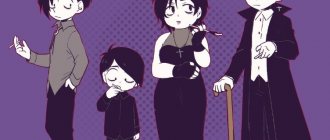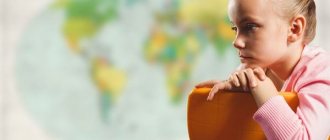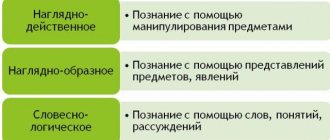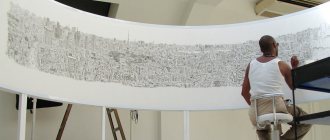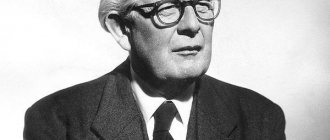A developed imagination is the key to a child’s success in the future. It is this quality that helps you learn easily, engage in scientific and creative projects, and find solutions in difficult situations. A rich imagination shapes a child’s personality and introduces him to the world of art and technology.
However, these qualities do not appear spontaneously in children. If you do not specifically develop them, then by the age of 18 these abilities will fade away.
This article contains effective exercises and tips that will help parents of preschoolers and school students develop their children's imagination and creative abilities.
Why work with imagination in childhood
Two by two is four
The basis of all learning is the reconstructive imagination. The ability to visualize something in your mind based on a verbal description or diagram. Everything that a child has ever seen and remembered, he can reproduce or imagine again.
Recreating imagination is a “path” to memory images. The better this ability is developed, the faster a person remembers and repeats already covered material. Multiplication tables, axioms and theories, historical facts, various definitions of concepts, etc.
But first, children learn to reproduce sounds, intonation, and words. They imitate adults in actions, developing their own line of behavior. The richer such experience, the more successful the process of communication and development of experience of interaction with other people.
“Stick, stick, cucumber - here comes the little man”
The functions of imagination are responsible for the preschooler’s ability to logically process new material, for example, to connect different parts into a single whole. Assemble a puzzle or construction set, determine the system of characteristics by which people belong to a particular profession, etc.
The formation of this skill begins in practice (for example, while playing with multi-colored cubes), later it moves entirely into the realm of imagination and allows you to operate with categories accessible only in theory (for example, the structure of planet Earth).
Ultimately, imagination allows you to connect elements together according to a certain logic, highlight any of them according to one or more characteristics, and restore the overall picture, conjecturing the missing elements.
The flying carpet, the frog princess and the little boy
The development of imagination in children of primary school age allows them to “juggle” various properties of known objects: to combine them, highlight the superfluous, replace, exaggerate some of them, simplify and turn them into diagrams, and much more. Ultimately, a new item will be created or an old one will be upgraded.
This skill allows you to transfer any actions from practice to theory and analyze the possible result. For example, conclude that tea will become tasteless if you add salt to it.
All opportunities for the development of creative imagination in preschool children serve its successful development, socialization and acquisition of useful skills. Ultimately, they give the opportunity to transform the world around them to suit their needs, when a person moves from the role of a subordinate to the rank of creator and manager.
Preschoolers' imagination
Ekaterina Borisovna Bannova
Preschoolers' imagination
Table of contents
Introduction….….2
1. The concept of imagination… . 3
2. Types and functions of a preschooler’s imagination… .…4
3. Forms of manifestation of a preschooler’s imagination... . ….5
4. Development of imagination in preschoolers... . 7
Conclusion….….11
Bibliography…. ….12
Appendix….13
Introduction
Imagination is the most important aspect of our life. Almost all human material and spiritual culture is a product of people's imagination and creativity .
Imagine for a moment that a person had no imagination. We would lose almost all scientific discoveries and works of art. Possessing a rich imagination , a person can “live” in different times, which no other creature in the world can afford. The past is recorded in memory images, arbitrarily resurrected by an effort of will, the future is presented in dreams and fantasies. Children would not hear fairy tales and
wouldn't be able to play many games. How could they learn
school curriculum without imagination ? It’s easier to say - deprive a person
imagination and progress will stop! Perhaps, if we can understand how creativity begins to take shape, the imagination develops in childhood , what determines this development, we will be able to find a path to creative freedom for all people - freedom in words, in feelings, in thoughts, in self-expression. If we understand what is especially important for the formation of a child’s abilities, his feelings, his ability to think, we can help him and give him the opportunity for the most complete development. It is necessary to open up as many paths as possible for the child and, of course, help him enter the world of creativity, imagination and fantasy . This means imagination , fantasy is the highest and most necessary ability of a person. At the same time, it is this
ability needs special care in terms of development. And it develops especially intensively between the ages of 5 and 15 years. And if the imagination is not specifically developed during this period, then a rapid decrease in the activity of this function occurs subsequently. Along with a decrease in the ability to fantasize, a person’s personality becomes impoverished, the possibilities of creative thinking decrease, and interest in art and science fades. The purpose of this work is to get acquainted with the mental function of imagination , ways of its development and optimization of learning for preschool children .
As studies by L. S. Vygotsky, V. V. Davydov, E. I. Ignatiev, S. L. Rubinshtein, D. B. Elkonin, V. A. Krutetsky and others have shown, imagination is not only a prerequisite for children’s effective learning of new knowledge, but is also a condition for the creative transformation of children’s existing knowledge, contributes to the self-development of the individual, i.e., it largely determines the effectiveness of educational activities in preschool educational institutions.
1. The concept of imagination
Imagination is the creation of images of objects and phenomena that have never been perceived by a person before.
Imagination cannot create out of nothing . It is built on transformed, processed material of past perceptions. These are images created by the greatest writers, inventions of designers.
Even fairy-tale images are always a fantastic combination of very real elements.
No matter how new something that is created by a person’s imagination , it inevitably comes from what exists in reality and is based on it. Therefore, imagination , like the entire psyche, is a reflection of the surrounding world by the brain, but only a reflection of what a person did not perceive, a reflection of what will become reality in the future.
According to E.V. Ilyenkov, the essence of imagination lies in the ability to “grasp”
the whole before the part, in the ability to build a complete image on the basis of a separate hint, the tendency.
A distinctive feature of imagination is a kind of “departure from reality
,” when a new image is built on the basis of a separate sign of reality, and not simply reconstructed existing ideas, which is typical for the functioning of the internal plan of action.
Imagination is a necessary element of human creative activity, expressed in constructing an image of the products of labor, and ensuring the creation of a program of behavior in cases where the problem situation is also characterized by uncertainty. Depending on the various circumstances that characterize the problem situation, the same problem can be solved both with the help of imagination and with the help of thinking. From this we can conclude that the imagination works at that stage of cognition when the uncertainty of the situation is very great. Fantasy allows you to “jump over”
through some stages of thinking and still imagine the end result.
Imagination is inherent only to man. According to E.V. Ilyenkov: “Fantasy itself, or the power of imagination , is one of not only the most precious, but also universal, universal abilities that distinguish a person from an animal. Without it, it is impossible to take a single step, not only in art, unless, of course, it is a step on the spot. Without the power of imagination , it would be impossible to even recognize an old friend if he suddenly grew a beard; it would be impossible even to cross the street through a stream of cars. Humanity, devoid of imagination, would never launch rockets into space.”
2. Types and functions of a preschooler’s imagination
imagination has two main functions - cognitive and affective. The main task of cognitive imagination is to recreate objective reality, complete the construction of a holistic picture of the world, and obtain new impressions. With the help of imagination, children can creatively master the patterns and meanings of human actions, build a holistic image of any event or phenomenon.
The affective function of the imagination is aimed at affirming and protecting one’s self. Such protection can be carried out in two ways. First, through repeated playback (or playback)
traumatic influences or situations, the child seems to distance himself from them and begins to see them from the outside.
Secondly, children create imaginary situations in which they can assert themselves - they feel strong, brave, dexterous, omnipotent. Cognitive and affective imagination can be seen quite clearly in the child’s directorial play.
The next stage in the development of a preschooler’s imagination is the age of 6-7 years . By this time, the child has already mastered the basic patterns of behavior and activity and gains freedom to operate with them. He is already free from learned standards and can combine them.
At this stage, purposeful planning appears: the child can already build a plan for their implementation before starting actions and consistently implement it, adjusting it as it progresses. A holistic image begins to be built by the method of inclusion, when the element given by the adult becomes only a minor detail of their own image of imagination .
Imagination can be defined as the ability to recombine and create new images. The main material for imagination is only a person’s own experience and knowledge. Since a child has much less such material than an adult, his imagination is not richer , but poorer. At the same time, imagination plays a much larger role in the life of a child than in the life of an adult—it manifests itself much more often and allows for a much easier departure from reality. The specificity of a preschooler's imagination lies in its increased emotionality: the child experiences imaginary events as acutely as real ones.
The first form of manifestation of children's imagination is games with an adult, included in an imaginary situation . most clearly manifested in the play of a preschooler (where children endow objects with imaginary functions , take on the roles of imaginary characters ) and in creative activities (drawing and verbal creativity)
.
In early preschool age, imagination is always based on real objects or actions; By older preschool age, imagination becomes possible on the internal plane , in terms of ideas.
There are two main functions of imagination - cognitive (reproduction and variation of real events)
and affective.
The cognitive imagination of a preschooler is associated with the rapid development of role-playing, drawing, and design. However, it is often of a reproducing nature, when the child acts according to patterns: he reproduces the same plots, and is inclined to draw template graphic diagrams. Affective imagination at this stage , as at the previous one, is aimed at overcoming the resulting psychotraumatic effects by repeatedly varying them in play, drawing and other creative activities. However, in cases of persistent conflict with reality, children often turn to substitute imagination . Both functions have their own line of development in preschool age .
Special pedagogical influences can contribute to the development of a child's creative imagination . To do this, it is good to use different versions of imagination (writing fairy tales, completing drawings of figures, designing according to plan, inventing plots, etc.).
3. Forms of manifestation of a preschooler’s imagination
Beginning and being formed in play, imagination moves into other types of activities of the preschooler . It is most clearly manifested in drawing and writing fairy tales and poems. Here, just as in a game, children first rely on directly perceived objects or strokes on paper that appear at their fingertips, and then they themselves plan their work. Children can change their idea several times during the drawing. The hump of a conceived camel can turn into the wing of a butterfly, which then becomes a bird, the moon becomes the sun, and the sun turns into a star or a flower. All these transformations are actively commented on in the speech of children and become clear only from these comments, since the images themselves vaguely resemble something specific. But children are not too picky about the quality of the drawing; their imaginations are much richer. Than images. Dots and dashes on paper represent forests, berries, wolves and hares, etc.
Verbal creativity opens up richer possibilities, not limited by any technical techniques. We have already noted that children are sincerely involved in literary works and live in this imaginary world . Many children themselves create various stories in which fantasy intersperses with reality.
With age, more and more space is given to speech in game plots, and action takes up less and less time. Imagination is increasingly separated from action and transferred to the speech plane. And since internal speech has not yet developed, the child needs a partner who mainly acts as a listener. This partner may not interfere in the game, but he is still needed as a support for the image. The child himself tells the content of the game and pronounces the lines of both his own and someone else’s character.
The child represents the structure or action of an object through his own action, taking on a role as an image in action. is very bright in the director's game . Children are happy to assign roles to toys and play out various stories with them. We can call this form of imagination subjective .
Accordingly, there is also a form that can be called objective. It manifests itself most clearly in construction, when a child, for example, is required to build a house for a doll. The dimensions of the house, room, and entrance must correspond to the height of the doll. If a child is busy solving a game problem, the house may be smaller than a doll. He will simply imagine that the doll lives there and lives comfortably. But when solving a design problem, this is impossible. The child’s internal position must be correlated with the real objective environment.
This is why play that develops imagination is so important for a child.
The influence of the game on the development of the child’s personality is that through it he becomes acquainted with the behavior and relationships of adults, who become the image for his own behavior, and in it he acquires basic communication skills and the qualities necessary to establish contact with peers. By capturing the child and forcing him to obey the rules corresponding to the role he has assumed, the game contributes to the development of feelings and volitional regulation of behavior.
By mastering the actions of the game, the child simultaneously masters the voluntary aspects of mental processes, as well as substitution actions. Also, the child gradually masters the human sign-symbolic world itself - first of all, the verbally outlined space that standardizes and socializes it, as well as a special sign-symbolic space where images of the imagination .
Formed in play, imagination moves into other activities of the preschooler . It is most clearly manifested in drawing and in the child’s writing of fairy tales and poems. Here, just as in a game, children first rely on directly perceived objects or strokes on paper that appear under their hand.
4. Development of imagination in preschoolers
A newborn child does not yet have imagination . Imagination develops in the process of a child’s life, in his activities, under the determining influence of living conditions, training and upbringing. To develop imagination, it is necessary to accumulate relevant experience and expand the range of ideas about the surrounding reality. This experience is acquired both through the child’s personal observations and through adults who pass on to him their knowledge about surrounding objects and phenomena and their creative experience.
Already in the 30s, L. S. Vygotsky proved that imagination develops gradually, as he acquires certain experience. Vygotsky argued that all images of the imagination , no matter how bizarre they may be, are based on those ideas and impressions that we receive in real life. He wrote: “The first form of connection between imagination and reality is that every creation the imagination is always built from elements taken from activity and contained in a person’s previous experience” Vygotsky L. N. Imagination and creativity in preschool age . - St. Petersburg: Soyuz, 1997.
In preschool age, the development of a child’s cognitive interests should proceed in two main directions:
1. Gradually enriching the child’s experience, saturating this experience with new knowledge about various areas of reality. This causes cognitive activity in the preschooler . The more sides of the surrounding reality open to children, the wider the opportunities for the emergence and consolidation of stable cognitive interests in them.
2. Gradual expansion and deepening of cognitive interests within the same sphere of reality.
In order to successfully develop a child’s cognitive interests, parents must know what their child is interested in, and only then influence the formation of his interests. It should be noted that for the emergence of stable interests, it is not enough to simply introduce a child to a new sphere of reality. He should have a positive emotional attitude towards the new. This is facilitated by the inclusion of the preschooler in joint activities with adults. An adult can ask a child to help him do something or, say, listen to his favorite record with him.
The feeling of involvement in the world of adults that arises in the child in such situations creates a positive connotation of his activities and contributes to his interest in this activity. But in these situations, the child’s own creative activity should also be awakened; only then can the desired result be achieved in the development of his cognitive interests and in the assimilation of new knowledge. You need to ask your child questions that encourage active thinking.
The accumulation of knowledge and experience is only a prerequisite for the development of creative imagination . Any knowledge can be a useless burden if a person does not know how to handle it and select what is necessary, which leads to a creative solution to the problem. And for this you need practice in making such decisions, the ability to use accumulated information in your activities.
Productive creative imagination is characterized not only by such features as originality and richness of the images produced. One of the most important properties of such imagination is the ability to direct ideas in the right direction, to subordinate them to certain goals. The inability to manage ideas, to subordinate them to your goal, leads to the fact that the best plans and intentions perish without being realized. Therefore, the most important line in the development of a preschooler’s imagination is the development of the direction of imagination .
In a younger preschooler, the imagination follows the subject and everything he creates is fragmentary and unfinished. Adults should help the child learn not just to fantasize fragmentarily, but to realize his plans, to create, albeit small, but complete works. For this purpose, parents can organize a role-playing game and, during this game, influence the child’s performance of the entire chain of game actions. You can also organize a collective composition of a fairy tale: each of the players speaks several sentences, and the adult participating in the game can direct the development of the plot and help the children complete planned. It is good to have a special folder or album where the most successful drawings and fairy tales composed by the child would be placed. This form of recording creative products will help the child direct his imagination to create complete and original works.
It is possible for a teacher in the older groups of a kindergarten to use TRIZ elements to develop the creative potential of children. Also, in special classes in music, drawing, design, and speech development, children need to be given creative tasks.
develop your imagination not only in special classes.
Play, which is the main activity of preschoolers . Adults should not just observe children's play, but manage its development, enrich it, and include creative elements in the game. At an early stage, children's games are objective in nature, that is, they are actions with various objects. At this stage, it is very important to teach the child to play with the same subject in different ways.
In addition, to develop imagination and creativity, there are special games that you can play with children in your free time. Interesting educational games were developed, for example, by B. N. Nikitin.
The richest source for the development of a child’s imagination is a fairy tale. There are many techniques for working with a fairy tale that educators can use to develop children’s imagination . Among them: “twisting” a fairy tale, inventing a fairy tale in reverse, inventing a continuation of a fairy tale, changing the end of a fairy tale. You can write fairy tales with your children. Speaking about the development of children's imagination with the help of fairy tales , one cannot help but recall the book by J. Rodari “The Grammar of Fantasy”.
So, how to develop the imagination of preschoolers ?
1. Use item substitutes. External support plays an important role in the development imagination If in the early stages of development (3 - 4 years)
the imagination of a preschooler is inseparable from real actions with toys, then in children 6 - 7 years old there is no longer such dependence. Their imagination may rely on objects completely different from those they replace. So, a child can ride a stick, imagining himself as a rider and the stick as a horse. After a few years, the need for external supports will gradually disappear. The child will be able to simply imagine actions with an imaginary object
2. Perform “objectification”
undefined object.
the method of “objectification”
at the age of 3-4 years. It lies in the fact that a child can see a completely specific object in an unfinished figure. So, in the task of completing the drawing, the child can turn a circle into a wheel or ball. By the age of 6-7 years, the child should be able to use this method freely.
3. Create images based on a verbal description or an incomplete graphic image. This ability is very important for the child’s future educational activities. The need to create images based on descriptions arises while reading a book and learning new words.
4. Spatial imagination . All objects in the surrounding world have spatial characteristics, and images of the imagination should reflect them. Therefore, it is very important to develop the child’s ability to “see”
image of an object in space. You can train this ability using games to imagine the relative placement of several objects in space.
5. Creation and implementation of a plan. Only consistent implementation of the plan can lead to achieving results. At this age there are already all the conditions for learning to act according to a pre-thought-out plan. Therefore, it is very important to develop this ability, to teach not just to fantasize aimlessly and in fits and starts, but to realize your ideas, create small but complete works (drawings, stories, designs)
etc.
With the help of imagination , children explore the world around them, coming up with explanations for everything new that they encounter in life. imagination needs to be developed from childhood, and the most susceptible period for this is preschool age .
Conclusion
So, we got acquainted with the most general aspects of development
children's imagination . We saw how important this function is for overall development
child, for the development of his personality, for the formation of life
experience. Due to the importance and significance of imagination for a child, it is necessary
assist in its development in every possible way and, at the same time, use it for
optimization of educational activities. The formation of imagination at an early age occurs as a change in the child’s innate activity into transformative activity. The decisive factor in this case is the need for new experiences and communication with an adult who opens up ways to receive impressions. When raising children's imagination , it is necessary to ensure that it is connected with life, so that it is a creative reflection of our reality. Getting acquainted with the life around him on walks, in conversations with teachers, the child then reflects what he perceived in his drawings, games, and in the process of this creative processing of accumulated experience, imagination .
It must be remembered that a preschooler’s imagination develops through activity: in play, in drawing, in classes in his native language. Therefore, the organization of these types of activities and their pedagogical guidance are crucial for the development of imagination .
an important role in the development of imagination . Listening to fairy tales and artistic stories, attending performances, looking at works of painting and sculpture that are understandable to him, the child learns to imagine the events depicted, and his imagination .
The development of imagination is not the result of direct instruction. It is due to the growing transformative activity of the child and the mechanisms of self-development of imagination : the opposite direction of varying and modeling elements of experience, schematization and detailing of images.
Bibliography
1. Borovik O. V.
Development of imagination . Guidelines.
2. Dyachenko O. M., Kirillova A. I.
3. Korobkova S. Teaching storytelling to children in kindergarten.
Application
Annex 1.
Basic types of imagination .
Exercises to develop imagination in preschoolers
The question of how to develop a child’s imagination can be answered: activities with a child vary depending on personal family preferences: you can attend special developmental schools or organize them at home. In the second case, the following exercises are perfect:
- Offer your child blanks (geometric figures drawn on paper or cut out, for older children - three-dimensional figures (cone, pipe, cube, etc.) and ask them to draw or glue new elements to it to make something original. The result may be: animals, objects, cartoon characters, etc.
- Assemble the puzzle. This can be an option from a store or made independently. To do this, you need to cut the picture on thick paper into several parts.
- Prepare flat geometric figures from colored paper or felt in advance, and invite your child to assemble a collage from them. It could be a bird, a house, a Christmas tree, etc.
- Invite your child to create their own house and help with the choice of materials. Sofa cushions, polypropylene rugs, bedspreads, boxes, etc. can be used.
Development of imagination in primary school age
Like the development of creative imagination in preschool children, the process of developing fantasy and creative opportunities for schoolchildren should contribute to positive personal development, be diverse and aimed at studying the social structure and knowledge of the world around them.
All activities are still of a gaming nature, but at a different level of complexity. It is important to include elements of self-control in classes and involve them in various types of activities. The more the child can do on his own, the better.
As a rule, parents and schools begin to make serious demands on their children as soon as they receive a new status, “first grader.” One involuntarily compares the capabilities and achievements of children. Parents should praise the results of their child’s work (“I like what you did,” “I’m glad you did it faster today,” “I love it when you do that,” etc.).
It is better to exclude comparisons with what other children have achieved: you need to monitor how the baby develops and compare only with the results that he received before (“I’m glad that today you did it yourself, without the help of adults,” “I I really like your drawing, all the lines in it are neat and it’s very bright”).
To develop imagination in free applied creativity classes for younger schoolchildren, it is important to avoid ready-made templates (“this is right, but this is wrong”), more appropriate formulations would be: “what should I do to make it a little neater?”, “I want to consult with you on what to come up with.” , to…". When it is important to teach a child some technique or technique, you should stipulate this: “now I will help you learn how to do ... there are certain rules that you need to follow.”
Discussing the task before class allows you to protect free creativity from criticism if the parents and the child have not agreed in advance what they are doing: learning to carefully follow the copybook (mom’s position) or drawing a variety of fancy scribbles (child’s opinion).
During this period, it is important to support parents in learning new material in academic subjects, but creative activities should not be relegated to the background, since only 1-2 lessons are devoted to them in the school curriculum.
The child’s cognitive activity during this period should be of a research nature, so that the student independently finds the materials he needs for learning. Open problems to solve, puzzles, mazes, etc. should be offered.
To develop a child’s attitude towards changed living conditions (the inclusion of school), and to himself, a positive attitude from parents, joint activities, weekend walks, and travel are important. It is necessary to include a playful moment in those activities where possible. All this develops and creates fertile ground for the development of imagination.
A negative influence in this regard will be the demands of the school and parents to “study well” (you must, look, this boy studies well, etc.) without paying attention to the needs of the child himself.
Development of children's creative imagination in drawing
Drawing is probably the most famous and widely used form of creative activity. Thanks to drawing, a child develops memory, learns to concentrate, improves fine motor skills, analyzes everything, compares, looks for differences, drawing makes the child think and think.
At a very young age, a child pays more attention to the qualities that this or that material has; the drawings of five-year-old children can already be understood and comprehended; at the age of 10, a child is already making plot-based drawings.
Important! Drawing helps to establish and strengthen the connection between the right and left hemispheres of a child’s brain, which is why it has such a strong influence on the baby’s development.
Drawing materials today are very diverse, from crayons to all kinds of paints.
We paint with paints (finger paints, watercolors, gouache)
In Europe, painting with children aged 6 months and older has been practiced for more than 20 years and has positive results.
It is the colors that give more scope for imagination.
- Firstly, they are more convenient to draw; when working with them, you do not need to make an effort, as when drawing with pencils or felt-tip pens.
- Secondly, they can be mixed and get new colors and shades.
- Thirdly, you can use different tools for drawing, the child can choose the method he likes most.
Finger paint
Finger paints are great for little ones because they are made from safe materials, and even if the child licks his finger in the paint, moms have nothing to worry about. In addition, such paints are easy to wash and wash off clothes. This is quite a nice bonus, because the baby will not limit himself to drawing only on paper.
Gouache
Gouache is suitable for slightly older children, from about two years old, because... it is not as safe as finger paints and is harder to wash. Gouache can also be painted with fingers, palms, or with a brush. Let the child first paint with it, as well as with his usual finger paints, and then show him how to do it with a brush.
Important! Children under 3 years old cannot hold a brush correctly and control the intensity of pressure, so don’t demand too much from your baby, let him master it.
Children really like gouache because... has the following properties:
- it is opaque;
- dissolves well in water;
- you can draw with it on canvas, on a sheet of paper, and even on wood;
- dries well and after drying becomes matte and velvety;
- odorless, therefore suitable for children;
- it is very dense, with rich color.
Drawing with gouache
From the age of two, a child can be given coloring books, just choose large drawings with a minimum of details to begin with. Show your child how to color without going overboard. Try different colors.
Important! Gouache is very good because you can mix colors and get new ones. The young researcher should enjoy this activity.
Watercolor paints
From the age of four, a child’s drawings already acquire more recognizable outlines and he can already be given watercolors.
Watercolor is a water-soluble paint, so it washes off easily with water. Paintings painted in watercolor create the impression of weightlessness, translucency and lightness.
The smaller the child, the fewer colors you choose to work with. For a schoolchild, 12 colors are enough, for younger children even less. The colors of watercolor paints can be mixed on a separate palette to create new colors and shades.
Important!
Also, to work with watercolors you will need brushes; it is better to choose soft and high-quality ones, for example, made from pony or squirrel hair.
Explain to your child that before taking a new color, the brush must be washed well in water, otherwise the colors will mix.
There is special paper for watercolors; it differs from regular paper in that the drawings on it are brighter and, accordingly, more vibrant. In addition, it will not wrinkle from moisture.
Exercises to develop imagination in younger schoolchildren
Since a child at this age already knows how (or is learning) to write and read, these opportunities should be actively used. Here are some examples of exercises that can be used in class:
- “Prepare a story based on the picture . After viewing a picture or a series of them, you should ask the child to come up with a complete plot in which all the characters are connected to each other. You can complicate the task by proposing new requirements: that sentences begin with a certain word (or end with it), that the story contains a riddle, that the story is told on behalf of one of the characters in the plot, etc.
- "Look into the future" . In this task, you should ask the student to draw or tell, or otherwise depict some object that does not exist now, but may exist in the future, which he will come up with. To expand perception, you can suggest thinking about a part of the imaginary world (a system of objects): roads, a park, city life, etc.
- “Attention, the artist is performing!” In this task, the child should be asked to independently perform some kind of act: a song, a dance, a scene from life, etc. It is important for adults to help with the choice of materials, but not to dictate their solution to the problem.

